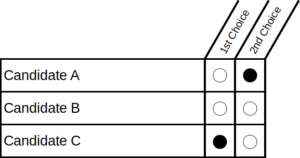Unlock Oregon Voting
Two-Rank Voting
- Vote for your first choice, and an optional second choice
- Simple and effective: operates like an instant runoff
- Evens the playing field for a challenger to the major parties
- Quickly embraced by those who reject other alternative methods
How it works
Two-rank voting works like our existing system with one important change: it gives you a second choice, which comes into play if your first choice isn’t competitive.
You can now consider candidates beyond the mainstream parties while still expressing a preference between the top contenders. Do you only like one candidate? Then choose one candidate. However, two-rank voting lets you back alternative candidates without concern for the spoiler effect.
What are the benefits of two-rank voting?
- Eliminates Vote-Splitting. Voters will no longer feel like they are throwing their vote away, or worse, harming the chances of winning for a preferred candidate when they vote outside the major parties.
- More Voice for Voters. Oregon’s diverse electorate wants their opinion heard at the polls.
- Encourages Multiparty Participation. After a minor party candidate acts as a spoiler to a major party, voters restrict their votes to the major parties in subsequent elections. Two-rank voting allows the minor political parties to grow when they run candidates with a broad appeal.
- Increased Political Engagement. Grassroots political activism, homegrown candidates, and individuals with good ideas have a greater chance to reach voters.
- Reduces Incentives for Negative Campaigning. Candidates are encouraged to take their case directly to Oregonians with a focus on the issues.
Why it works
Under our current system, the minor parties grow in popularity until they act as a spoiler for the more similar major-party candidate. When that happens, the voter’s more disliked candidate gets elected, undermining the goals of those voters. Voters respond by restricting their vote to “viable” candidates in subsequent elections. This prevents the alternative parties from growing to a size needed to compete with the major parties.
Two-rank voting frees voters to support their favorite candidate, which, in turn, makes third party candidates more viable.
Where has two-rank voting been used?
Two-rank voting, also known as supplementary vote (in the U.K.) and top-two ranked-choice voting, has been used for electing Mayors and Police and Crime Commissioners in the UK. Since 2000, when the first mayoral election was held in London, 212 elections have been held using the T2V across the U.K.
Two-rank voting is the most simple form of ranked-choice voting, which is used in 55 cities, counties, and states, including Maine, Alaska, and San Francisco. 1
The current system isn’t working
The 2020 Oregon General Election saw a 97% incumbency win rate, excluding local races.2 Often, major party candidates are judged by the national stances of their party, which can lead to one party dominating in many areas. It’s no surprise that “voter participation tends to be lower in countries with FPTP [our existing voting system] than elsewhere.”3 4
Please visit our FAQ for further details.
